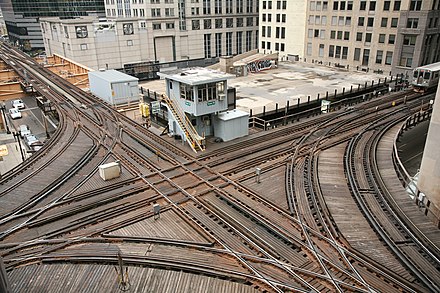Rail transport
Rail transport (also known as train transport) is a means of transport that transfers passengers and goods on wheeled vehicles running on rails, which are incorporated in tracks. In contrast to road transport, where the vehicles run on a prepared flat surface, rail vehicles (rolling stock) are directionally guided by the tracks on which they run. Tracks usually consist of steel rails.
Rolling stock in a rail transport system generally encounters lower frictional resistance than rubber-tyred road vehicles, so passenger and freight cars (carriages and wagons) can be coupled into longer trains. The operation is carried out by a railway company, providing transport between train stations or freight customer facilities. Power is provided by locomotives which either draw electric power from a railway electrification system or produce their own power, usually by diesel engines or, historically, steam engines. Most tracks are accompanied by a signalling system. Railways are a safe land transport system when compared to other forms of transport.[a] Railway transport can carry heavy traffic of passengers and cargo at high energy efficiency, but often with less flexibility and more capital intensity than road transport, where traffic is lighter.
The oldest known, man/animal-hauled railways date back to the 6th century BC in Corinth, Greece. Rail transport resumed in mid 16th century in Germany in the form of horse-powered funiculars and wagonways. Modern rail transport began with a British steam locomotive in 1802. The Locomotion No. 1 became the first steam locomotive to carry passengers on a public rail line, the Stockton and Darlington Railway in 1825, and the first public inter-city railway line, the Liverpool and Manchester Railway, opened in 1830.
Steam engines brought mainline railways, a key component of the Industrial Revolution. Shipping cost less, and fewer goods were lost, than in water transport. The change from canals to railways allowed for "national markets" in which prices varied little from city to city. The use of railway timetables led to standard railway time replacing local mean time. The invention and development of the railway in the United Kingdom was one of the most important technological inventions of the 19th century. The world's first underground railway, the Metropolitan Railway (part of the London Underground), opened in 1863.
In the 1880s, railway electrification began with tramways and rapid transit systems. Starting during the 1940s, steam locomotives were replaced by diesel locomotives, with steam becoming rare by the 2000s. During the 1960s, electrified high-speed railway systems were introduced in Japan and later in some other countries. Many countries are in the process of replacing diesel locomotives with electric locomotives, mainly due to environmental concerns, as in Switzerland, which has completely electrified its network. Guided ground transport outside the traditional railway definitions, such as monorail or maglev, have been tried but have seen limited use.
Following a decline after World War II due to competition from cars and airplanes, rail transport has had a revival in recent decades due to road congestion and rising fuel prices, as well as governments investing in rail as a means of reducing CO2 emissions in the context of concerns about global warming.
